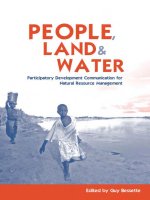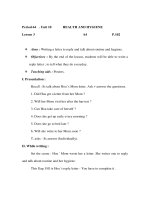3 6 3 land and water
Bạn đang xem bản rút gọn của tài liệu. Xem và tải ngay bản đầy đủ của tài liệu tại đây (3.18 MB, 10 trang )
Fascinating Facts
• The Nile River in Egypt is the world’s longest
river, but the Amazon River in Brazil moves the
most water.
• The world’s largest freshwater lake is Lake
Baikal in Russia.
• The highest temperature ever recorded in the
world is 136°F (58°C) in the Sahara.
Genre
Nonfiction
Comprehension Skill
Main Idea
and Details
Text Features
• Glossary
• Headings
• Captions
Scott Foresman Social Studies
ISBN 0-328-14824-5
ì<(sk$m)=beicea< +^-Ä-U-Ä-U
In this book you will read about the impact
of the physical environment on different
communities. You will explore communities
near water, in the desert, and in the
mountains. In each of these regions, the
land and the communities are related in
specific ways.
Vocabulary
community
Write to It!
You have read about many kinds of
communities with different geographical
features. Which type of community would
you most like to live in? Why? Write one
paragraph about your ideas.
Write your paragraph on another sheet
of paper.
location
transportation
population
culture
Photographs
Every effort has been made to secure permission and provide appropriate credit for photographic material. The publisher deeply
regrets any omission and pledges to correct errors called to its attention in subsequent editions.
Unless otherwise acknowledged, all photographs are the property of Scott Foresman, a division of Pearson Education.
Photo locators denoted as follows: Top (T), Center (C), Bottom (B), Left (L), Right (R), Background (Bkgd)
ISBN: 0-328-14824-5
Copyright © Pearson Education, Inc.
All Rights Reserved. Printed in the United States of America. This publication is protected
by Copyright, and permission should be obtained from the publisher prior to any prohibited
reproduction, storage in a retrieval system, or transmission in any form by any means,
electronic, mechanical, photocopying, recording, or likewise. For information regarding
permission(s), write to: Permissions Department, Scott Foresman, 1900 East Lake Avenue,
Glenview, Illinois 60025.
1 2 3 4 5 6 7 8 9 10 V0G1 14 13 12 11 10 09 08 07 06 05
Opener: (T) ©Getty Images, (C) ©Getty Images, (B) ©Getty Images
Editorial Offices: Glenview, Illinois • Parsippany, New Jersey • New York, New York
2 ©Royalty-Free/Corbis, (Bkgd T, B) ©Digital Vision, (Bkgd L, R) ©Getty Images
3 ©Ronnie Kaufman/Corbis
Sales Offices: Needham, Massachusetts • Duluth, Georgia • Glenview, Illinois
5 ©Getty Images
Coppell, Texas • Sacramento, California • Mesa, Arizona
6 ©AP/Wide World Photos
7 ©Bob Krist/Corbis
9 ©James Marshall/Corbis
10 ©Frans Lemmens/Getty Images
13 ©Royalty-Free/Corbis
15 ©Getty Images
Different Kinds of Geography
If you live near an ocean, you can spend time
swimming and playing in the water. Someone you
know might earn money by fishing or driving a
tugboat. In a coastal community, people’s way of
life is connected to the ocean.
If you live in a desert, your daily life is probably
very different. You might eat toast with jam made
from the fruit of a Saguaro cactus. Your family
might like to hike on cliffs and in canyons.
People live in many different places, and each
location affects the communities that are found in
these places.
Each different
environment has
benefits and
challenges for the
people who live
there. To survive in
different surroundings,
people adapt, or
adjust to them.
In some cases people
must adapt to the land.
In cold climates, for
example, you cannot
change the weather but
In cold climates people need
you can learn how to
warm clothing.
keep warm. Sometimes,
people change the land to fit their needs. In the
mountains people have made tunnels and roads in
the mountains to make travel easier.
Cactuses grow in
the deserts.
2
3
Living near Water
When you look at a globe, you will see that most
of Earth’s surface is covered with water. Bodies of
water cover almost three-fourths of Earth. Most of
that water is the ocean.
Oceans are huge bodies of salt water that
separate large areas of land. There are four oceans
on Earth. The Pacific Ocean is the largest, and it
borders the western United States. The Atlantic
Ocean borders the eastern United States. The
Indian Ocean contains many islands. The Arctic
Ocean has parts that are frozen all year long.
Many of the world’s largest cities are located on
ocean coasts. In the United States there are larger
populations on the coasts than in between.
The fishing and shipping industries provide jobs
for people who live in coastal cities.
Communities are often located near rivers. As
water from rain and melting snow moves from high
places like mountains to lower places like oceans
or lakes, a system of rivers and streams is formed.
4
Rivers are also important for transportation.
Before there were many roads, rivers were an
important way to travel across land. After, towns
were built near them and away from rivers.
Populations grew in areas far from rivers. Today,
the Mississippi River is a waterway for cargo boats.
5
People enjoy sporting activities at many lakes.
Lakes are bodies of water surrounded on all
sides by land. Many lakes began thousands of
years ago when large sheets of ice called glaciers
moved slowly across Earth. These glaciers carved
holes that filled with water from rain or melting ice.
Many people enjoy living around lakes because
of their natural beauty and the opportunities they
provide for sporting activities. In lake communities,
people may enjoy boating, fishing, and swimming.
Lake areas often get a lot of snow, so they are also
good for skiing and sledding.
Lake areas attract a lot of visitors. Tourism can
be big business in lake communities.
6
Some people live on islands. Islands are pieces
of land that are surrounded on all sides by water.
Islands are found in oceans.
Some islands are often small and have less than
one hundred residents. Some islands are home to
an entire country. The interior land on many islands
is mountainous. This means the population may be
the greatest on the outer edges of the island.
Travel between islands and the mainland affects
life on the island. People can drive over bridges or
through tunnels to get to and from some islands.
Other islands, however, can only be reached by
plane, boat, or ship.
People who live on islands must plan carefully
if they depend on supplies from somewhere else.
When there is bad weather, people on islands may
be unable to get supplies they need.
Bridges to
an island
may be safer
to travel on
than boats
and planes
during bad
weather.
7
There are many benefits to living near water, but
communities must be careful not to harm Earth’s
water environments.
In coastal areas, huge cities with millions of
people can strain the area’s natural resources.
Sandy shorelines can be worn away. Ocean water
can become polluted. The fish and shellfish that
feed many people can be taken out of the ocean
faster than they can be replaced.
Only three percent of Earth’s water supply is the
fresh water that people drink. Water pollution is a
threat to this water.
People must protect the water, but they must
also protect themselves from dangerous weather
that sometimes comes to coastal communities.
Hurricanes with heavy rains can cause floods
that damage homes and buildings. In very rainy
seasons rivers can overflow. People who live near
water must know how to be safe.
8
9
Living in a Desert
Deserts are dry places that receive less than
ten inches of rain per year. Even though water is
so important to life, people have lived in deserts
since ancient times.
Desert land can be sandy or rocky. There may
be large flat areas as well as hills in desert areas.
Animals and plants that live and grow in the desert
have adapted to having little water.
Desert weather can be extreme. The days are
very hot, and the nights are very cold. There are
sandstorms, high winds, and blowing sand. When
it rains, it can be sudden and often heavy, so there
can be floods.
10
A small area within a desert with a good water
source and many green plants is called an oasis.
Some people who live in the desert may live near
an oasis and move from place to place as the
water supply changes. Their homes are tents that
are light and easy to pack and carry.
In modern desert homes there may be air
conditioning. People try to stay indoors during the
hottest parts of the day.
Desert clothing also must be light to keep a
person’s body cool and protected from the sun. It
is important to wear a hat and sunblock!
Some deserts are cold instead of hot. The
continent of Antarctica is a desert. Even though
there is lots of ice and snow, it hardly ever rains or
snows there.
11
Living near Mountains
Mountains are tall, natural landforms that rise into
peaks, or tops. Much of the land on mountains is
covered by forests. The tallest mountains have snow
on their peaks. As the temperature changes, the
snow from high up on a mountain melts and runs
down the mountain into streams and rivers where it
provides water for people. In this way, mountains are
one of Earth’s most valuable resources.
For early explorers getting over or around
mountains was very difficult. Today, there are
roads over some mountains and tunnels through
some mountains.
There are many countries, however, where it
is still hard to move around in the mountains. In
these areas getting supplies from place to place
can be difficult. Most of the land is not good for
farming, so survival still can be challenging for
people living in some mountain areas.
In the valleys growing some food is possible.
There also may be urban centers on the edges of
mountain areas where living is easier.
Many people enjoy taking
vacations in mountain areas.
12
13
Sharing the Land
All communities share their surroundings with
plants and animals. There are some flowers that
grow only in the mountains and others that grow
only in the desert. Camels can live in the desert
because they can survive with little water. Each
environment influences the plants and animals
that live there.
Every community is special, and all communities
create a culture with customs and traditions
related to the environment around them.
Transportation, food, and clothes are all affected
by where people live.
14
Visiting communities around the world can be
both exciting and interesting. If you want to try
skiing, you can go to the mountains. If you want
to explore the desert, you can visit Arizona. If you
have never played in the ocean waves, you might
want to give it a try.
Each kind of landscape—deserts, mountains,
lakes, rivers, and oceans—all offer important
resources to communities. Earth is one place we
all need to take care of and share.
15
In this book you will read about the impact
of the physical environment on different
Glossary
communities. You will explore communities
community
where and
people
live, work,
near water, ainplace
the desert,
in the
and have fun
mountains.
In together
each of these regions, the
culture
thethe
arts,
beliefs, behavior,
and ideas
land and
communities
are related
in
of a group
of people
specific
ways.
location where something can be found
population the number
of people in an area
Vocabulary
community
transportation a way
of carrying things
or people from place
to place
location
Write to It!
You have read about many kinds of
communities with different geographical
features. Which type of community would
you most like to live in? Why? Write one
paragraph about your ideas.
Write your paragraph on another sheet
of paper.
transportation
population
culture
Photographs
Every effort has been made to secure permission and provide appropriate credit for photographic material. The publisher deeply
regrets any omission and pledges to correct errors called to its attention in subsequent editions.
Unless otherwise acknowledged, all photographs are the property of Scott Foresman, a division of Pearson Education.
Photo locators denoted as follows: Top (T), Center (C), Bottom (B), Left (L), Right (R), Background (Bkgd)
ISBN: 0-328-14824-5
Copyright © Pearson Education, Inc.
All Rights Reserved. Printed in the United States of America. This publication is protected
by Copyright, and permission should be obtained from the publisher prior to any prohibited
reproduction, storage in a retrieval system, or transmission in any form by any means,
electronic, mechanical, photocopying, recording, or likewise. For information regarding
permission(s), write to: Permissions Department, Scott Foresman, 1900 East Lake Avenue,
Glenview, Illinois 60025.
16
1 2 3 4 5 6 7 8 9 10 V0G1 14 13 12 11 10 09 08 07 06 05
Opener: (T) ©Getty Images, (C) ©Getty Images, (B) ©Getty Images
2 ©Royalty-Free/Corbis, (Bkgd T, B) ©Digital Vision, (Bkgd L, R) ©Getty Images
3 ©Ronnie Kaufman/Corbis
5 ©Getty Images
6 ©AP/Wide World Photos
7 ©Bob Krist/Corbis
9 ©James Marshall/Corbis
10 ©Frans Lemmens/Getty Images
13 ©Royalty-Free/Corbis
15 ©Getty Images









